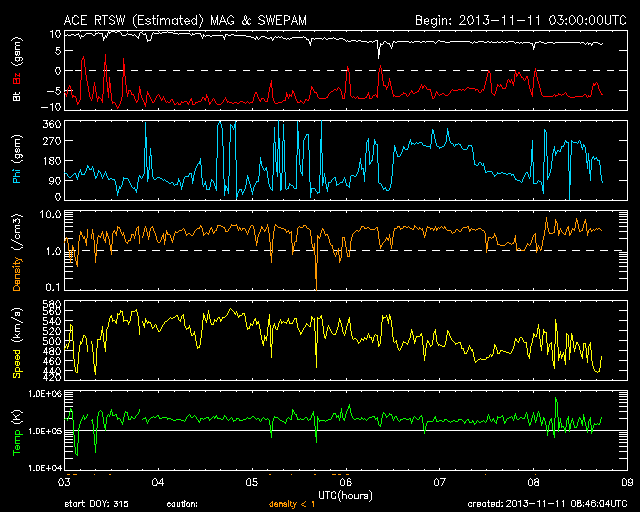November 11, 2013 Auroras
Grand Rapids, MN
A coronal hole high speed solar wind stream had settled in a couple days before with the corotating interaction region (CIR) providing a nice show in other places, but Minnesota had cloudy skies. Usually, once the high speed stream arrives, the total magnetic field decreases to around 4 or 5 nT, and the solar wind speed increases to around 600 km/s. While the high speed solar stream produces some auroras on its own (for some reason, I generally see tall columns when the H.S.S. is hitting Earth), it is the stronger southward magnetic field that occurs in the CIR that really brings the auroras farther south towards Minnesota. Some examples can be found on February 19, 2012, June 1, 2013, and June 29, 2013. All of those events occurred as the CIR ahead of a coronal hole high-speed solar stream swept path Earth, and the interplanetary magnetic field became less than -10 nanoTesla. In the present case, however, the CIR had passed more than a day prior, so I wasn't expecting to see much.
I was pleasantly surprised, however, when the magnetic field again became relatively strong (7 to 10 nT). It was November, which means the skies are often too cloudy to see auroras. Today, we also had a strong cold front moving through, and, as expected for this time of year, the cold front provided clouds and snow showers, but there was a window of opportunity immediately behind the cold front as the wind kicked up, and sinking motion immediately behind the front allowed the skies to clear. Even with the clearing, the upward moisture flux from the still-open lakes brings the air closer to its saturation point, and clouds begin to form within the cold airmass. Thus, the window of opportunity to shoot auroras would be short.
Due to the city lights reflected off the clouds, it was tough to differentiate between auroras and city lights, but as I got north of town, the difference became more obvious. I stopped on County Road 61 to snap a couple pictures.
| Band of aurora over a field on County Road 61 north of Cohassett. |
The relative lack of clouds on the horizon told me I could continue north, so I moved to Pughole Lake, where I shot for about 30 to 60 minutes before the clouds moved in again. In the meantime, the left front tire of my car was going flat, and I did not notice that before pulling into the Pughole Lake boat landing.
| Aurora over Pughole Lake. |
While I was there, the tire lost its remaining pressure and became completely flat. I drove out from the boat landing and immediately noticed a lot more resistance on the left front tire. I turned down my music and hear a somewhat loud tire noise coming from the right front of the vehicle. I decided it was best to stop at the intersection of Highway 39 and County Road 19 (half a mile south of the boat landing) to have a look at that part of the car. Indeed, it had gone completely flat. I had to swap it with the spare tire.
| Aurora over Pughole Lake. |
 |
|---|
| Magnetic field during the evening and overnight. |